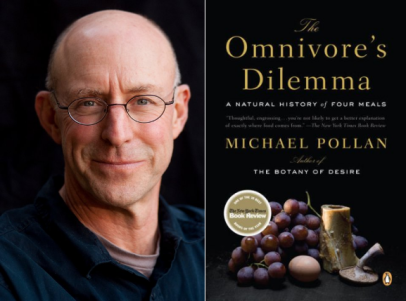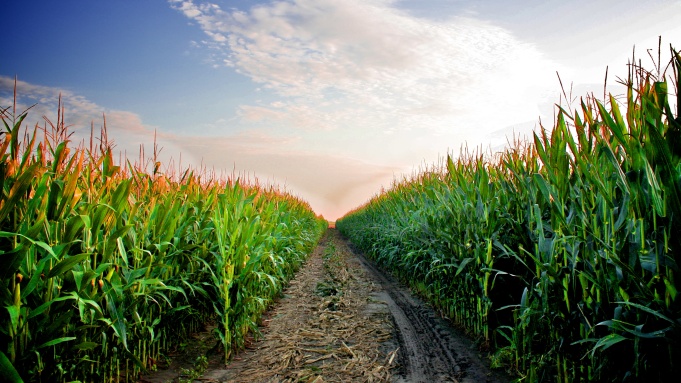
Pollan, M. 2006. The Omnivore’s Dilemma: A Natural History of Four Meals. Toronto: Penguin Group. p. 15-119.
Well, after a day of adventuring through vineyards, sampling wine, and witnessing a wall of potatoes (seriously, a WALL of potatoes!), I find myself writing this blog. “What am I eating? And where in the world did it come from? ” (p.17). These are the questions that author and journalist Michael Pollan discusses in his book The Omnivore’s Dilemma. This book investigates the ways in which our food is sourced in a humorous, and at times absolutely grim fashion. The Omnivore’s Dilemma first delves into the world of corn, a staple in the diets of many people around the globe.
Pollan begins his investigation into the life of corn by speaking with a man named Todd Dawson, a biologist at Berkeley University. Dawson states that ‘we North Americans look like corn chips with legs,‘ (p.23) referring to the enormous amount of processed corn products that are now so commonly consumed in our society. Who would’ve thought that out 45,000 items in the average American supermarket, over a quarter of them contain corn in some way, shape, or form? (p.19). It is incredible to me that one product can be utilized and transformed into sweeteners, oils, feed, fuel, and more! Although, as I was reading through the vast list of processed and genetically altered corn products, I began to have a sick feeling in my stomach. Wait, is there corn in the juice I’m drinking? Why would there need to be corn in my juice?! I quickly glanced at the label – ‘cane sugar’. That’s better than corn syrup, right? Right?
One aspect I’ve really enjoyed in this book so far is how Pollan tells the story of George Naylor, “a big man with a moon face and a scraggly gray beard,” (p.33) throughout the first section. Naylor speaks of how a century ago, their Iowa farm used to support their entire family (including an additional 12 Americans by providing “fruits and vegetables, as well as oats, hay and alfalfa to feed the pigs, cattle, chickens, and horses – horses being the tractor of that time,” (p.34). It is so difficult for me to comprehend how much has changed on the Naylor farm in just over a century; George says his farm “can no longer support the four who live on it,” (p.34). This struggle of modern-day farming really struck me today, as we visited a local potato and onion farm, ‘Green Acres Vegetable Farm Ltd.’ Jimmy Dhaliwal toured us around the farm and showed us the masses of potatoes (they were literally walls of potatoes – floor to ceiling!*) and onions that their farm produced – and how there are three major customers that buy their produce. The dependency on those three customers is so great, that if one was lost, their farm would most likely have to generate new customers (which proves to be difficult in the current market), otherwise they would struggle to support not only themselves, but the labour force who they’ve hired.
As a history geek, I found the advent of chemical fertilizers after World War II extremely interesting; the ammonium nitrates that were being used for developing forms of chemical warfare were being utilized to synthetically fertilize our agricultural crops (p.41). As Vandana Shiva stated, “We’re still eating the leftovers of World War II,” (p.41) – what an incredibly powerful statement. On the Naylor farm, they believed in alternating crops of corn and legumes (which fix nitrogen, then providing nitrogen to the soil) in order for the corn to have sufficient nitrogen levels. This changed with the introduction of these synthetic fertilizers, and it would change the agriculture industry forever.
It is also incredible to think that corn crops have transformed the Earth – our landscapes have “been completely remade my man,” (p.38). Pollan discusses not only our landscape changes due to corn, but the changes within us. Did anyone else begin to feel sick when Pollan visited the feedlots? I have to admit, reading the chapters discussing the cattle feedlots nearly had me in tears. These cattle are force-fed a diet which is unnatural for them (in the form of cornmeal, etc.) which are then filled with synthetic proteins, hormones, and at one time, beef by-products (basically, they were forcing cannibalism upon these cattle in order for them to ‘bulk up’ at a quicker rate). How do we as humans justify these acts? We belittle these animals by feeding them unnatural diets, due to our extreme increases in corn production (which has also likely been synthetically fertilized, and chemically and genetically altered). Humans do suffer the consequences by altering the diets of cattle – Mad Cow disease originated from cattle eating cattle; I find it very sad that we reached the point where feed lots are normalized in our society. If only raising animals could be as simple as it once was on the Naylor farm; “You can feed them the waste products of your crops, and you can feed their waste products to your crops,” (p. 67).
What an incredibly insightful and thought-provoking book – I will definitely be waiting to read more! Pollan has a way of transferring valuable knowledge through his experiences, which makes reading his books an absolute delight. In this book, Pollan encourages the reader to think about these questions: “Where is my food coming from?” and “How did this food reach my plate?”, both of which are extremely important to ask. I will end this blog with this thought, “You are what what you eat eats,” (p. 84). Brilliant.
Until next time,
Kristi

Love the title! – sad but so true!
Similarly I noted in my blog how Pollan’s humorous writing style contrasted with the “grim” or dark side of this story. “As Vandana Shiva stated, “We’re still eating the leftovers of World War II,” (p.41)” – that part tho.. so brutal. To be honest I found myself soooo frustrated and angered at points!
I found myself thinking throughout this read how far is far enough? how much damage to the environment, farmers and crop animals is enough for people to get a reality check that this “evolution of corn” is not okay!?
Well, Pollan succeeded – anyone who reads this has to ask themselves: “Where is my food coming from?”
🙂
I agree great title! I found myself looking at my juice as well. Glucose and Fructose Syrup were the first ingredients in my orange juice. How sad! Looks like Pollan had everyone reading their food labels!
I liked that you added images into your blog. It made an even bigger impact supporting your words, and it was also nice to put a name to a face, seeing a picture of Michael at the top. You created a very nice style and structure to your blog. It was very interesting to read and seems like we gathered the same thoughts from this weeks reading.